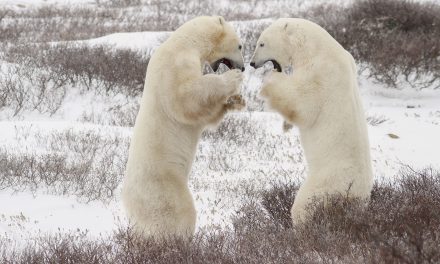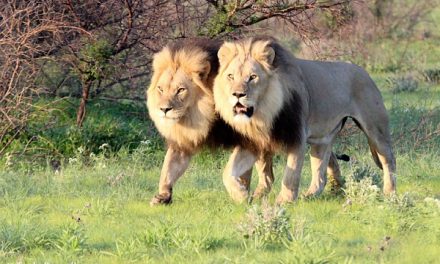
This stunning photo of an adult female mountain lion “cheek-rubbing,” leaving her scent on a log, was taken in the Verdugo Mountains. Downtown Los Angeles is in the far background. ©National Park Service
The largest wild cat in North America, the mountain lion—also known as a catamount, cougar, panther and puma—has powerful limbs and can leap as high as 15 feet and as far as 40 feet. That makes it an expert at attacking prey from behind. It also tends to make hikers in mountain lion territory wary.
It’s estimated that 30,000 mountain lions live in the American West. Visitors in many national parks—including Bryce Canyon, Glacier, Rocky Mountain, Sequoia, Yellowstone, Yosemite and Zion—are urged by the National Park Service to keep an eye out when hiking in the backcountry. A new study, however, shows that these cats fear us far more than we have reason to fear them.
What’s even more important is that such trepidation of humans is changing how mountain lions feed. That, in turn, is causing ecological changes that can reshape whole environments.

The National Park Service asks visitors in Yellowstone National Park to watch out for mountain lions when hiking in the backcountry. ©Henry H. Holdsworth
Frog croaks preferable to human chatter
In a study published in the June 21, 2017, online edition of the science journal Proceedings of the Royal Society B, biologists at the Santa Cruz Puma Project, a research effort in the mountains of California’s central coast, exposed mountain lions in the Santa Cruz Mountains to the sound of human voices in order to test their reactions.
Normally, mountain lions ambush their prey and stash the carcass nearby, which allows them to feast over several nights. However, recent research projects had shown that the animals were behaving strangely around human habitats. According to a 2015 study, when people are in the vicinity, female mountain lions tend to abandon or eat less of their kill. To compensate, the cats killed 36 percent more deer in these areas.
To find out what led to this rise, scientists in the new study used data collected from GPS collars to locate mountain lion kill sites in the Santa Cruz Mountains from December 2015 to June 2016. They then set up cameras and sound speakers in the areas where the animals had passed the night before. After a mountain lion triggered a motion sensor, filming would start and a speaker would play recordings either of chirping Pacific tree frogs, common to the soundscape of the Santa Cruz Mountains, or the voices of political talk show hosts taken from high-quality audio clips.

The animals studied resided in the Santa Cruz Mountains, in a region between the Pacific Ocean to the west and Highway 101 to the east. ©Dipika Bhattacharya, flickr
The results were striking: during the 29 experiments run with 17 mountain lions, the animals fled in 83 percent of the cases where human voices were played. When recordings of Pacific tree frog vocalizations were broadcast, only once did one mountain lion flee.
The cats also took longer to return to their kills after hearing the human voices, reducing their feeding on these kills by half. (Each mountain lion was tested only once so as not to cause undue stress and chase any one animal off its kill multiple times.) The results indicate that unable to eat an entire carcass in peace, mountain lions are forced to kill more deer, ironically often placing them in contact with more humans.
This is the first study to experimentally link the fear of humans to feeding behavior in large carnivores.

The solitary and elusive nature of mountain lions makes them difficult to research and hard to count. ©California Department of Fish and Game
Our power to alter puma proclivities
This study has far more implications than just establishing the mountain lion’s fear response to humans. It reveals how the animals’ well-being and continued existence may soon deteriorate in our increasingly human-dominated landscapes. More time spent hunting can mean less time caring for young. In fact, a female mountain lion in the most developed area of the Santa Cruz team’s study area has lost three litters of kittens in as many years; one because of abandonment. Other females in less-developed regions saw a higher kitten survival rate.
So why do mountain lions fear us? California banned the hunting of mountain lions in 1990, designating them a “specially protected species.” And today, they’re not considered endangered or threatened.
But humans still are the leading cause of death among mountain lions. We continue to kill those that eat livestock, and they are frequently hit by cars. Rodenticide poisoning and the state-sanctioned hunting of mountain lions that have killed livestock or pets take another toll. In addition, many mountain lions depend upon severely fragmented and degraded habitats that are so unconnected that they are on the edge of genetic viability. According to the Mountain Lion Foundation, trophy hunters are killing more mountain lions today than at any other time in our nation’s history—more, even, than were killed during America’s bounty period when residents were paid for helping eliminate unwanted species; and quotas continue to be increased every year. People are responsible for the deaths of more than 3,000 mountain lions in the U.S. annually.

It’s possible that human avoidance behavior is passed down from generation to generation. ©Henry H. Holdsworth
It’s clear that mountain lions should be afraid of us; that fear might help them to coexist with us, reducing the likelihood of a human-mountain lion meeting. But how they learn this behavior isn’t as apparent. All of the mountain lions in the study had some form of human habitation or development within their home range and thus were likely to have experienced interactions—some of them probably negative—with people. It could also be that kittens, which spend up to a year with their mom, learn appropriate human avoidance behavior from her.
Numbers aren’t enough if behavior isn’t considered
While it may seem that maintaining populations of large, carnivorous animals in close proximity to humans is counterintuitive and even potentially dangerous, mountain lions pose little threat to us and are important for keeping ecosystems in balance. They prevent the explosion of populations of smaller predators, such as coyotes and raccoons, and large herbivores, such as deer, that can devastate biodiversity when unchecked. Mountain lions keep deer herds on the move so that they do not overgraze in any particular area, a behavioral change that results in less erosion along riverbanks and increases habitat for other species, such as songbirds.
What this new study demonstrates is that if the fear of humans is changing the way mountain lions interact with their prey, just having the large carnivores present may not be sufficient to allow them to fulfill their important ecological role. We need to consider how our activities affect not just species abundance but also behavior if we want to maintain healthy, sustainable ecosystems that contain a richer balance of nature.

For mountain lions to continue to thrive, wildlife corridors that connect protected habitats are essential. ©Lil Rose, flickr
Mountain lion mindset
The voice clips used in the study came from political talk show hosts that were male, female, conservative and liberal. The mountain lions ran from them all. That caused some to remark, tongue-in-cheek, that mountain lions are nonpartisan in their hatred of American politics. Of course, in reality, it wouldn’t have mattered where the voice clips had come from: it was the fact that they were human that scared the mountain lions off.
It does, however, make us think about how “the others” must see us—all of us, no matter our political leanings. Perhaps we should all work on changing that.
Here’s to finding your true places and natural habitats,
Candy



































A good article .. Always new perspectives
Excellent article!!
I am astonished that this study is considered to be news: Anyone across the world who has spent any time in areas where wildlife has been exposed to humans knows that the human form and the human voice is anathema to wildlife. Elephants in Kenya even distinguish between different tribal languages let alone different people. In areas where humans have not been present animals have no fear of humans. In all other areas the run for their lives or hide when they see a human or hear any sound made by humans. The truth of the matter is that animals see us all as the bad guys, and if there were such a thing as a devil in the animal world the human animal would be it.
Mountain lions follow their prey. In near mountain communities like our Front Range cities and towns, deer become abundant and they and mountain lions become familiar with humans because they are not hunted within or near city limits. They lose their fear of humans with such daily contact. In the case of mountain lions, many humans likely show fear, which the lion can detect, especially if the human runs away. Some humans may actually troll for conflict by walking their dog in areas frequented by lions (or coyotes). Mountain lions may avoid contact with humans and our voices may alert lions to our presence, but I doubt they “fear” the sound of our voice unless they associate our voice with a likely attack with guns.
Not in upper Wisconsin where I have 3 hunting dogs and 3 children; the noise of people is a constant din and yet there is multiple sightings weekly. Both on hunting cams and by people on the ground. Perhaps it Is because the exposure is so high that they have adapted and become less fearful?